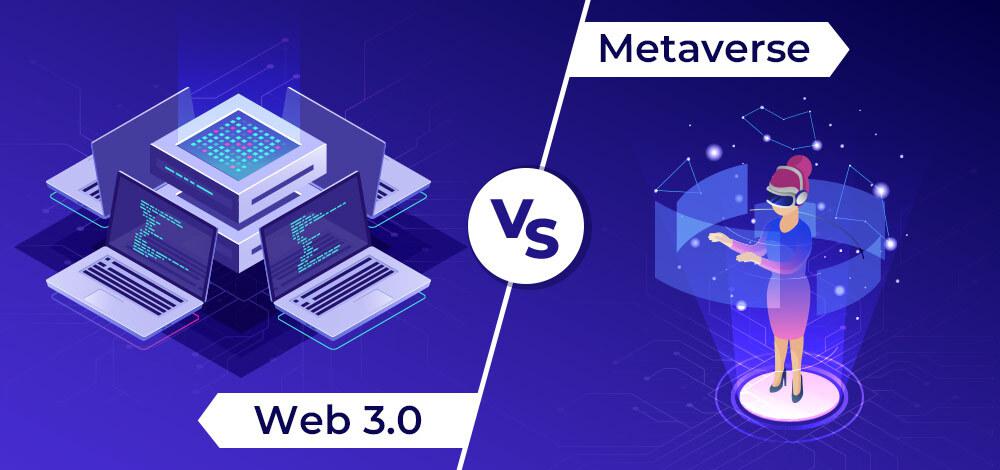Web3 and Metaverse – two omnipotent words or terms that are generating hype and bringing a wave of excitement to the world of finance and business. Most people are still unaware that the world is shifting from Web2 to Web3 and often confuse these terms. Although they are related in several important ways, they both represent different concepts. The world is moving swiftly toward Web3 –
- From AWS to IPFS
- From LLC to DAO
- From Physical assets to NFT
- From Chrome to Brave
- From bank to Metamask
- From monopoly centralized systems to decentralized blockchains
- From Facebook to Steemit
Since the world is shifting toward the new gen of the internet, we need to see what’s the difference between these two terms. Before that, let’s see what is web3 and metaverse to understand these two terms in brief.
What is Web3?
Web3 shifted the way we use the internet today, moving us from Web 1.0 which was the online version that operated from around 1991 and 2004. It was more focused on consumers rather than creators. Web 2.0 is the opposite of Web 1.0 or can say shifted to a creator-based world. It has come to illustrate the ensuing iteration of the internet: one loomed by user-generated content. This was when everyone started interacting through Facebook and other social media networking sites, creating and sharing videos on YouTube, and sharing comments and views.
Then comes Web3 which was surprisingly predicted by Gavin Wood, co-creator of the Ethereum blockchain, who expected the internet of the future to be centered on blockchain technology. Web3 refers to the decentralized internet based on distributed technologies such as Blockchains and Decentralized Autonomous Organizations (DAOs) and not centralized servers.
The objective is that this will result in a more democratic Internet. No one party will be able to restrict the flow of information and terminate a network just because they possess the hardware on which it runs. In principle, the servers, systems, and networks from which applications are run and data is kept will be owned by the users, who would have voting rights over what rules and restrictions are in place and how they may be utilized.
It is expected to be the third significant development of the internet, following the worldwide web (web1) and the user-generated web (web2, or social media).
What is Metaverse?
The Metaverse is a virtual world. Yes, it’s just a fancy term that has replaced the word “cyberspace“. The word itself refers to a wide (and frequently hypothetical) shift in how humans engage with technology, rather than any one specific sort of technology. And it’s certainly feasible that the term itself may become obsolete as the technology, it previously defined, becomes more widespread.
The term “metaverse” didn’t just come out of the mouth of Meta founder Mark Zuckerburg first. However, the term was first featured in Neal Stephenson’s sci-fi novel Snow Crash, which depicted a world of virtual reality. Since then, books and films such as Ready Player One and The Matrix have hyped the term to popularize it.
Generally, the technologies that businesses allude to when they talk about “the metaverse” might include Virtual Reality or VR (defined by persistent virtual environments that exist even when you’re not playing) and AR or Augmented Reality (which blends features of the digital and physical worlds). However, it doesn’t mean that those areas will be obtained only through VR/AR.
How Does the Metaverse Work?
In the metaverse, users travel across a virtual world that simulates aspects of the physical world using technologies such as virtual reality (VR), Augmented Reality (AR), and Mixed Reality (MR). People in the metaverse utilize avatars to represent themselves, connect with one another, and virtually construct the community. In the metaverse, digital cash is used to purchase clothing, weapons, and shields in video games, and a variety of other products. Users may also use a virtual reality headset and controllers to journey through the metaverse for leisure with no specific objective in mind.
Microsoft and Meta (formerly known as Facebook) are among the companies developing technology for interfacing with virtual worlds, but they are not alone. Many more huge corporations, like Nvidia, Unity, Roblox, and even Snapchat—along with some smaller firms and startups—are laying the groundwork for improved virtual worlds that more closely resemble our actual lives.
While the majority of today’s metaverses are gaming platforms populated by youngsters, if the concept takes off as advocates predict, it might change the way we all work, socialize, and interact online. Instead of communicating with your coworkers via a video conferencing service like Zoom or Google Meet, you could put on a VR headset and interact with their avatars in a virtual area – all from your living room.
Instead of communicating with pals through text or Facebook Messenger, your group can arrange to meet at a virtual concert where famous bands are playing in real-time but you can experience them through VR/AR and interact with their avatars. Talk about saving space and time!
How do Web3 and Metaverse Connect with Each Other?
While the metaverse and Web 3.0 aren’t the same things, they’re also not opposing visions of the future internet – one, both, or none may happen, and there could be some overlapping that may happen in the future.
A digital artist may, for example, design an outfit for an avatar to wear in the metaverse and then sell it at auction alongside an NFT. This would give the buyer sole ownership of the costume; if others duplicated it, their avatars would be wearing knock-offs. There’s also the potential that we’ll wind up with a Web 3.0 that we access through desktops and cellphones, rather than VR headsets.
That’s especially plausible if the tech sector can’t overcome present technology constraints. Intel recently asserted that computers will need to be 1,000 times more efficient to support the metaverse, and to date, we’re yet to receive VR headsets that are comfortable and inexpensive for us to wear. Not everyone can afford $599 or INR 49k worth of VR headset!
What’s the Difference Between Web3 and Metaverse?
|
Basis |
Web3 |
Metaverse |
|---|---|---|
| Definition | Web 3.0 will be based on a decentralized blockchain system that will not allow for centralized ownership of information, services, or platforms. | The Metaverse is a 3D interactive experience space that allows users to interact with 3D objects using augmented, virtual, and mixed reality. |
| The Application’s Scope | It’s applicable throughout the internet. | Currently, it’s in progress as it’ll take time to develop and some of the areas are still under scrutiny. |
| Target | Web3 targets blockchain-controlled and peer-to-peer controlled facilities. | Metaverse targets AR, VR, and MR/XR facilities. |
| Application | It applies to democratic internet systems and permissionless financial networks like Crypto. Web 3 leverages ML, AI, and blockchain to attain real-world human communication. | It applies in the virtual gaming world, 3D surgeries, peer-to-peer virtual meetups, etc. |
| Depiction | Individuals can own the internet and regulate it on their own accord. | Turning physical materials into virtual material in a virtual world. |
| Underlying technology | Blockchain, DeFi, NFTs, DAOs. | AR/VR, 3D Reconstruction, Internet of Things (IoT), Edge Computing & 5G, Blockchain. |
| Technical | Powered by DAO (Decentralized Autonomous Organization), AI, and Blockchain. | Powered by 5G communication, extended reality, brain-computer interfaces, cloud computing, blockchain, digital twins, creators economy, and artificial intelligence. |
Must Read
Conclusion
The metaverse will be omnipresent in the far future, as well as Web3, but for the time being, we are unclear. We may infer that the metaverse is a three-dimensional universe in which you can connect with three-dimensional people, items, and locations. You may, for example, play games with your pals from the creator’s ground. Users may nurture, own, sell, and acquire their material in the case of Web3. People can also charge for their work. Because this system is still in its early stages, we must constantly monitor it to see if it deepens the divide or wants to merge in the near future.
FAQs
What is Web3, and how does it differ from Web1 and Web2?
Web3 is a decentralized network giving people greater authority over their data and transactions. Web 1 was a static web focused on information consumption, while Web 2 transformed into a social web, empowering users to create and interact with content.
What is Metaverse, and what technologies contribute to it?
The Metaverse is a virtual world where users engage with technology, using Virtual Reality (VR), Augmented Reality (AR), and Mixed Reality (MR). Technologies contributing to the Metaverse are AR,VR,MR,Internet of Things (IoT), Edge Computing, 5G, blockchain, and more.
How do users interact in the Metaverse?
In the Metaverse, people use VR and AR technologies to explore and interact. They create avatars to represent themselves and engage with the virtual community.
Where do Web3 and the Metaverse overlap?
Web3 and the Metaverse can overlap in areas like NFTs, auctions, and digital ownership.
What are the underlying technologies of Web3 and Metaverse?
Web3 uses blockchain, DeFi, NFTs, and DAOs to aim for decentralized internet and financial systems. The Metaverse is made to run by technologies such as AR/VR and 5G communication.





